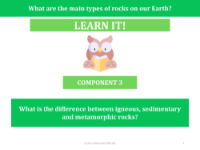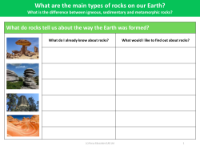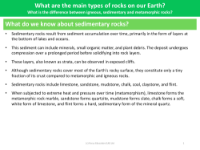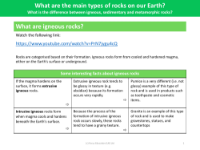What is the difference between igneous, sedimentary and metamorphic rocks? - Teacher notes

Science Resource Description
Igneous, sedimentary, and metamorphic rocks are the three main types of rocks found on Earth, each formed through different geological processes. Igneous rocks are born from the cooling and solidification of molten magma or lava. As the hot liquid cools, either beneath the Earth's surface as intrusive rocks or after erupting onto the surface as extrusive rocks, it crystallizes to form solid rock. Examples of igneous rocks include granite and basalt, with their characteristic interlocking crystals that are often visible to the naked eye.
Sedimentary rocks, on the other hand, are formed from the accumulation and compaction of mineral and organic particles over time. These particles, or sediments, are deposited by water, wind, or ice, and over long periods, they are compressed into layers that eventually harden into rock. Sedimentary rocks can often be identified by their distinct layers, or strata, and they may contain fossils of ancient organisms. Common examples include sandstone and limestone. Metamorphic rocks are created when existing rocks are subjected to intense heat and pressure within the Earth's crust, leading to physical and chemical changes. This process, known as metamorphism, can alter the rock's original structure and mineral composition, producing a new type of rock. Metamorphic rocks, such as marble and slate, often have a foliated or banded appearance due to the reorientation of minerals under stress.






